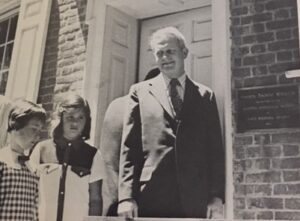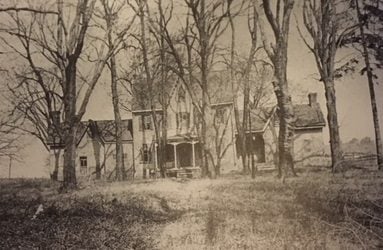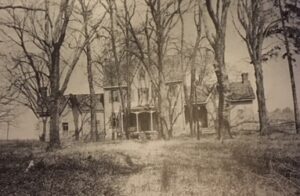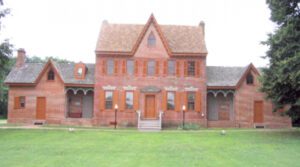On Saturday, December 2 at 10 AM, volunteers will begin “greening” the Parson Thorne Mansion, decking the historic building in festive holiday colors. The project is done in partnership with the Milford Garden Club.
“The wreaths and other greenery used to decorate the mansion are not store bought,” Brooke Clendaniel, a trustee of the mansion, said. “They are created for us by talented members of the garden club.”
In addition to adding holiday décor to the mansion, the Milford Historical Society, the organization trusted with the preservation and maintenance of the property, built prior to 1785, is embarking on an ambitious fund raising campaign. Funds will be used toward the restoration and preservation work on the mansion. The goal of the campaign is $50,000.
“Major projects, especially the roof, cannot be put on hold,” Clendaniel said. “We are in a crisis situation. Roof patching was necessary until funds were available for a major project of new shingled roofs. We are very grateful for funding provided by the state legislature this year that will help us fund this project, but there are other items that needed to be addressed, including the HVAC system and flooring.”
Other projects planned for the mansion include the restoration of a “sharecropper’s” cottage which will provide visitors with a glimpse into how a sharecropper, someone who leased land from mansion owners, lived. Another project is a barn-style welcome and visitor’s center to house offices, provide venue space and educational programs. There would also be space for information about Milford and the surrounding area. A plantation manager’s office and period kitchen are also planned, but require HVAC work in order to preserve artifacts that will be housed there. Donations can be made at https://degives.org/milford-historical-society.
According to documents created by the Milford Historical Society, although it was believed that the mansion was constructed in 1785 by Reverend Sydenham Thorne, Silver Hill, which is the official name of the mansion, was actually built by Joseph Booth, Sr. and John Cullen before Parson Thorne was ever born. According to research, although Joseph Oliver created the town center by dividing building lots, Milford actually started as a trading post at the headwaters of the Mispillion River. The construction of the mansion began a slow shift downstream to where Milford stands now.


James Richard Draper at the transfer of deed ceremony when the mansion was gifted to the Milford Historical Society
John Bowman Sr. sold 500 acres to Booth Sr. but died before the deal could be completed. However, his son, John Jr., executed the deed in 1730 for payment of 22 pounds (£3905.79 today or $4,932.14). Young Bowman took two pounds for himself in addition to the 20 pounds agreed on by his father. Booth Sr. then built a dwelling on the hill as well as a dam across the river where Parson Thorne later built his dam. The portion of the mansion built by Booth Sr. is now the rear wing. There is also evidence the east wing was constructed as a kitchen.
There was resistance to the dam constructed by Booth Sr. as it would have meant the end of the trading post at the mouth of the river, known as Cullentown. Booth died in 1735, heavily in debt, and his land was reduced to about half the size and mortgaged for 120 pounds (£21,304.33 today or $26,892.84). The property was sold to Joseph Cullen at a sheriff’s sale for 72 pounds (£12,782.60 today or $16,135.59). This allowed Cullen to stop the construction of the dam and to build the mansion that stands today.
At the time the mansion was constructed, there was no railroad track. There were no retail store, apartments or houses nearby. The Cullen family’s grand home overlooked the Mispillion Creek with ships sailing to his landing at Cullentown. Cullen used the dwelling built by Booth and added the front section along with two wings, likely around 1750.
Over time, the waters near Cullentown began to grow shallower and there was a growing demand for grist mills to process grain. These grist mills required dams, leading to a need for a more centralized town center. In 1773, John Cullen was elderly and William Cullen, who was likely his son or close relative, operated a store in Cullentown. John Cullen’s will divided his estate into three parts, one to William, one to his son Jonathan and one to his son George. The mansion was left to Jonathan with lifetime rights reserved for his father, John.
In 1774, Jonathan sold his share of the estate, including the mansion, to his brother George, and in 1775, John Cullen passed away. Just a few months later, Jonathan also passed away with no children. In 1785, George executed a deed selling Silver Hill Mansion to Parson Thorne. By this time, Oliver had acquired land in what is now downtown Milford. The Delaware General Assembly granted Parson Thorne the right to construct a dam and mill in the location where Booth Sr. chose for his dam.
Parson Thorne married Betty Crapper, the wealthy widow of Levin Crapper, who built Causey Mansion. It is believed that she funded the purchase of Silver Hill Mansion and that there may have been some family relationship between Betty Thorne and Joseph Oliver as her will mentions a sister, Esther Oliver. This was Betty Thorne’s third marriage as she was married to Manual Manlove before Levin Crapper. After Parson Thorne died, she married Peter Lowbar.
In addition to owning the mansion, Parson Thorne was also granted land to build a church in 1791. This church is now Christ Church, but Parson Thorne died before it was completed. After Parson Thorne’s death, parishioners were reluctant to move to the new church and it was not completed until 1835.
After his death, Parson Thorne’s nephew, Peter Caverly inherited Silver Hill Mansion, along with the parson’s many business ventures. When The Commercial Bank of Delaware, which became Farmer’s Bank, was established, Caverly became its cashier and moved to Dover. In 1811, the mansion, dam and mill along with almost all of Parson Thorne’s former rental properties, were deeded to James Clayton for $11,000 ($275,152.93 today).
Unfortunately, Clayton overextended himself and died in debt in 1820. He and members of his family are buried in a plot on the mansion property, which was purchased by his son, John M. Clayton, who served as United States Secretary of State under President Zachary Taylor. Secretary Clayton purchased the plot from Colonel Benjamin Potter who purchased the mansion at sheriff’s sale in 1821. The deed listed Colonel Potter as two-thirds owner and his son, Edmund, one-third for the sum of $3880 ($105,642.79 today). Colonel Potter then purchased ten acres of the original Thorne tract and added it to the mansion property.
Colonel Potter lived in the mansion until his death in 1843. Edmund died before him without heirs and the mansion passed to a nephew, Benjamin Potter who was only 11 when he inherited. From 1858 to 1861, Governor William Burton lived in the mansion, although it was still owned by young Benjamin. He sold the mansion to his father-in-law, Henry Fiddeman, in 1858 for $10,000 ($375,208.54 today).
It is believed that Governor Burton lived in the mansion throughout the Civil War, but it is not clear when he moved from the property. Fiddeman conducted a careful survey of the property and, in 1879 before making extensive alterations to Silver Hill.
“He rebuilt the house frame of the rear wing,” a note found during the restoration of the mansion in 1963 read.” A study of the rear wing at the time of restoration shows that he replaced wall studs on the east side and, in doing so, removed the noggin wall on that side and replaced it with lath and plaster. He also put on new weatherboarding, new cornice boards and a new roof. He also changed the front section to give it a Victorian rather than colonial appearance. A large front porch was erected to replace the earlier stoop and the front of the house had large pane windows installed.
After his death, Fiddeman’s daughter, Mary Lofland, lived in the mansion until she died in 1911. She was the last owner to occupy Silver Hill. Edward Walls lived in the house for some time and then it was occupied by tenants. Eventually, the home passed to the Draper family and eventually, James Richard Draper, who considered living in the mansion. However, in 1961, he gifted the mansion to the Milford Historical Society who began the work of restoration.
Funding restraints limited what the society could do, but major work has been completed. This included removing the Victorian porch and returning the original stoop, new windows, repair of frames and lintels, exterior and interior paint, removal of the exterior imitation brick siding, replacement with weatherboarding copied from the original, installation of plumbing and electricity as well as repair of fireplaces, hearths and wall sections.
For more information on the Milford Historical Society or to volunteer, contact [email protected].
RELATED STORIES:
Share this Post





